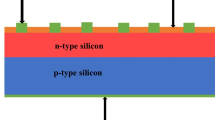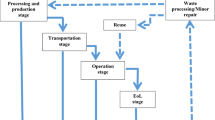Abstract
The environmental performance of photovoltaic (PV) module is more affected by its operating module temperature and wind flow throughout the PV module. It finally impacts on output power of module. This work describes a new way for estimation of module temperature effects on seasonal performance variation of three different modules of PV technologies i.e. (Amorphous-Silicon (a-Si), Hetero-junction with Intrinsic Thin-layer (HIT) and Multicrystalline-Silicon (mc-Si)) installed at National Institute of Solar Energy (NISE), Gurgaon site in India. First time under this research work, results have been estimated based on technique of finding new coefficient at the site by considering same reported module temperature model format followed by observing the RMSE of predicted module temperature. This estimation also uses for PV module performance improvement. This work also presents, the estimation of the module temperature model coefficients and their Root Mean Square Error (RMSE) of three different technology. Further, the efficiency and output power of PV module temperature model also estimated. The percentage power deviation from standard test condition (STC), and RMSE between predicted power and measured power was evaluated. While doing comparison of the three different PV technology module’s parameter in terms of efficiency and output power, HIT module found to be the well performed PV technology than a-Si and mc-Si for the NISE site. The method discussed in this work can be useful for performance assessment of large solar plant across the world.












Similar content being viewed by others
REFERENCES
Ndiaye, A., Kebe, C., Charki, A., Ndiaye, P., Sambou, V., and Kobi, A., Degradation evaluation of crystalline-silicon photovoltaic modules after a few operation years in a tropical environment, Sol. Energy, 2014, vol. 103, pp. 70–77.
Skoplaki, E., Boudouvis, A.G., and Palyvos, J.A., A simple correlation for the operating tempera-ture of photovoltaic modules of arbitrary mounting, Sol. Energy Mater. Sol. Cells, 2008, vol. 92, no. 11, pp. 1393–1402. https://doi.org/10.1016/j.solmat.2008.05.016
Nordmann, T., and Clavadetscher, L., Understanding temperature effects on PV system performance, Third World Conference on Photovoltaic Energy Conversion, Osaka, Japan, May 11–18, 2003, pp. 2243–2246.
TamizhMani, G., Ji, L., Tang, Y., and Petacci, L., Photovoltaic module thermal-wind performance: Long-term monitoring and model development for energy rating, NCPV and Solar Program Review Meeting, Denver, CO, March 24–26, 2003, pp. 936–939.
Tripanagnostopoulos, Y., Souliotis, M., Battisti, R., and Corrado, A., Energy, cost and LCA results of PV and hybrid PV/T solar systems, Prog. Photovoltaics: Res. Appl., 2005, vol. 13, no. 3, pp. 235–250.
Evans, D.L. and Florschuetz, L.W., Cost studies on terrestrial photovoltaic power systems with sunlight concentration, Sol. Energy, 1977, vol. 19, pp. 255–262.
Magare, D., Sastry, O. S., Gupta, R., Kumar, A., and Sinha, A., Data logging strategy of photovoltaic (PV) module test beds, 27th European Photovoltaic Solar Energy Conference (EU PVSEC), Frankfurt, Germany, September 24–28, 2012, pp. 3259–3262.
Magare, D., Sastry, O., Gupta, R., Bora, B., Singh, Y., and Mohammed, H., Wind effect modeling and analysis for estimation of photovoltaic module temperature, J. Sol. Energy Eng., 2017, vol. 140, no. 1, p. 011008. https://doi.org/10.1115/1.4038590
Lasnier, F. and Ang, T.G., Photovoltaic Engineering Handbook, New York: Adam Hilger, 1990, p. 258.
Chenni, R., Markhlouf, M., Kerbache, T., and Bouzid, A., A detailed modelling method for photovoltaic cells, Energy, 2007, vol. 32, no. 9, pp. 1724–1730.
King, D.L., Kratochvil, J.A., and Boyson, W.E., Photovoltaic array performance model, Report No. SAND2004-3535, Albuquerque, NM: Sandia Natl. Labs., 2004.
Duffie, J.A. and Beckman, W.A., Solar Energy Thermal Processes, Hoboken, NJ: Wiley, 2006, 3rd ed.
Skoplaki, E., and Palyvos, J.A., Operating temperature of photovoltaic modules: A survey of pertinent correlations, Renewable Energy, 2009, vol. 34, no. 1, p. 2329. https://doi.org/10.1016/j.renene.2008.04.009
Magare, D., Sastry, O., Gupta, R., Mohammed, H., Bora, B., and Singh, Y., Estimation of operating condition frequency distribution and power prediction by extending application of IEC 61853-1 standard for different technology photovoltaic modules, J. Renewable Sustainable Energy, 2018, vol. 10, no. 3, p. 033507. https://doi.org/10.1063/1.5023084
King, D.L., Photovoltaic module and array performance characterization methods for all system operating conditions, NREL/SNL Photovoltaic Program Review Meeting, Lakewood, CO, Novenber 18–22, 1997, pp. 1–22.
Ross, R.G., Jr. and Smokler, M.I., Flat-plate solar array project final report. Vol. VI: Engineering sciences and reliability, Report No. DOE/JPL-1012-125, Pasadena, CA: Jet Propulsion Laboratory, 1986.
Kurtz, S., Whitfield, K., TamizhMani, G., Koehl, M., Miller, D., Joyce, J., Wohlgemuth, J., Bosco, N., Kempe, M., and Zgonena, T., Evaluation of high-temperature exposure of photovoltaic modules, Prog. Photovoltaics: Res. Appl., 2011, vol. 19, no. 8, pp. 954–965.
Nichinte, A.S., Vyawahare, V.A., and Magare, D., Estimation and comparison of module temperature model coefficient for different PV technology module, 2020 3rd Int. Conf. on Communication System, Computing and IT Applications (CSCITA), Mumbai, India, 2020, pp. 13–17. https://doi.org/10.1109/cscita47329.2020.9137798
Magare, D.B., Sastry, O.S., Gupta, R., Betts, T.R., Gottschalg, R., Kumar, A., and Singh, Y.K., Effect of seasonal spectral variations on performance of three different photovoltaic technologies in India, Int. J. Energy Environ. Eng., 2015, vol. 7, no. 1, pp. 93–103. https://doi.org/10.1007/s40095-015-0190-0
Mabrouk, A., Ayman, A., Bader, A., and Adel, F., Comparative performance evaluation of different photovoltaic modules technologies under Kuwait harsh climatic conditions, Energy Rep., 2020, vol. 6, pp. 2689–2696. https://doi.org/10.1016/j.egyr.2020.09.034
ACKNOWLEDGMENTS
Authors would like to thank National Institute of Solar Energy (NISE), Gurgaon, India for providing experimental research data, also, thank to Advanced Industrial Science and Technology (AIST), Japan, for PV test beds installed at site NISE, Gurgaon, Haryana District, northern India.
Funding
This work was not financial supported.
Author information
Authors and Affiliations
Corresponding author
Ethics declarations
The authors declare that they have no conflicts of interest.
About this article
Cite this article
Magare, D.B., Nichinte, A.S. & Vyawahare, V.A. Estimation of Module Temperature Effects on Seasonal Performance Variation of Different Photovoltaic Technology Modules. Appl. Sol. Energy 58, 226–237 (2022). https://doi.org/10.3103/S0003701X22020116
Received:
Revised:
Accepted:
Published:
Issue Date:
DOI: https://doi.org/10.3103/S0003701X22020116




